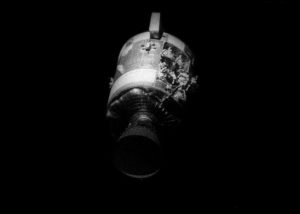
This Saturday will mark a half century since the ill-fated Apollo 13 mission to the moon launched from the Florida coast on April 11, 1970. Apollo 13 was planned to be NASA’s third manned mission to land on the lunar surface, and, despite a few minor issues, went according to plan—until disaster struck about 56 hours into the journey. As the crew were approaching the moon, an explosion took place on the service module, blasting open a panel, damaging equipment, and venting oxygen into space. Rapid calculations and actions by the astronauts and Mission Control in Houston were able to salvage life-support systems, alter course to return to Earth (skipping the lunar landing), and get the crew safely home. Events that could have resulted in tragedy became stories of ingenuity, perseverance, and survival. Below, a few images from those eventful days 50 years ago.
An earlier version of this photo essay inadvertently included a photo from a previous Apollo mission. The photo has been removed.

This view of the severely damaged Apollo 13 service module was photographed from the lunar module/command module following service-module jettisoning on April 17, 1970. As seen in this cropped image, enlarged to provide a close-up view of the damaged area, an entire panel on the service module was blown away by the apparent explosion of an oxygen tank. #
NASA

Apollo 13 astronauts leave the Manned Spacecraft Operations Building en route to a van that will take them to launch pad 39A for their liftoff on a lunar-landing mission. Mission commander James Lovell leads astronauts John Swigert and Fred Haise, far left. #
NASA / Bettmann / Getty

A view of the Mission Operations Control Room during a television transmission from the Apollo 13 mission in space. Eugene F. Kranz (foreground, back to camera), one of four Apollo 13 flight directors, views the large screen, while astronaut Fred W. Haise Jr., lunar-module pilot, is seen on the screen. #
NASA

On the way to the moon, shortly after the maneuver to attach the lunar module to the command module/service module, a view out the window, looking at the Saturn V rocket’s third stage, which had been carrying the lunar module. It was jettisoned and set on a course to crash into the moon to facilitate seismic tests. #
NASA

A view inside Mission Control Center during the Apollo 13 oxygen cell failure on April 14, 1970. An explosion on the service module had sent the crew scrambling to respond, leading them to notify Mission Control with the famous words “Houston, we’ve had a problem” (later erroneously popularized as “Houston, we have a problem”). #
NASA

Headlines of London evening newspapers describe the Apollo 13 troubles, and the battle to bring the astronauts and their crippled spaceship back to Earth on April 14, 1970. #
Eddie Worth / AP

Marilyn Lovell (standing, second from right), wife of astronaut Jim Lovell, prays at the Lovell home during the Apollo 13 crisis, in Houston, Texas, on April 15, 1970. #
Bill Eppridge / The LIFE Picture Collection via Getty

A view of the lunar surface as Apollo 13 swings around, using the moon’s gravity to slingshot back home to Earth. The spacecraft flew 158 miles above the surface of the far side of the moon, incidentally leading the crew to set the record for the farthest distance humans have ever been from Earth: 248,655 miles (400,171 km). #
NASA

Yet another problem: excess carbon dioxide inside the spacecraft on the return journey. Deke Slayton (checkered jacket) shows an adapter devised to make use of lithium-hydroxide canisters to remove the excess carbon dioxide from the Apollo 13 lunar-module cabin. #
NASA

An interior view of the Apollo 13 lunar module, showing some of the temporary hose connections and apparatus that were necessary when the three Apollo astronauts moved from the command module to use the lunar module as a “lifeboat”. Astronaut John L. Swigert Jr., command-module pilot, is on the right. An unidentified astronaut on the left holds in his right hand the feed water bag from the portable life-support system. #
NASA

An in-flight photo of the “mailbox” device constructed by the crew from duct tape, maps, and other materials they had on hand as instructed by Houston. This device allowed use of lithium-hydroxide canisters in conjunction with the lunar module’s environmental-control system, to scrub carbon dioxide from the air inside the spacecraft. #
NASA

This view of the severely damaged Apollo 13 service module was photographed from the lunar module/command module, following service-module jettisoning. The lunar module was jettisoned just prior to Earth reentry by the command module. #
NASA

In New York City’s Grand Central Station, all eyes are focused on the giant television screen, watching for the safe landing of the Apollo 13 astronauts in the Pacific, on April 17, 1970. #
J. Spencer Jones / AP

Parachutes deployed, the Apollo 13 spacecraft drifts toward a safe splashdown. The command module splashed down in the South Pacific Ocean at noon on April 17, 1970. #
NASA

Celebrations in the Mission Control Center, after the successful return of the Apollo 13 mission. Dr. Donald K. Slayton (in black shirt, left of center), director of flight-crew operations at MSC, and Chester M. Lee of the Apollo-program directorate, Office of Manned Space Flight, shake hands, while Dr. Rocco A. Petrone, Apollo-program director, Office of Manned Space Flight (standing, near Lee), watches the large screen showing astronaut James A. Lovell Jr. In the foreground, Glynn S. Lunney (far left) and Eugene F. Kranz (smoking a cigar), two Apollo 13 flight directors, view the activity from their consoles. #
NASA

Astronaut James A. Lovell Jr. reads a newspaper account of the safe recovery of the problem-plagued mission. Lovell was on board the U.S.S. Iwo Jima, prime recovery ship for Apollo 13, which was on a course headed for Pago Pago. From Pago Pago, the astronauts flew to Hickam Air Force Base, Hawaii. #
NASA

President Richard Nixon and the Apollo 13 astronauts stand at attention for the national anthem at a ceremony welcoming their safe return and awarding them with the Presidential Medal of Freedom. #
Robert Knudsen / Richard Nixon Library / Nixon Presidential Materials Staff

Confetti pours from the skyscrapers in Chicago’s financial district, as Apollo 13 astronauts John Swigert Jr., (waving left), and James Lovell ride in a motorcade during a parade in their honor on May 1, 1970. #
AP




















